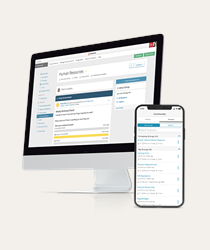resources
Signs of Disengaged Employees and How to Re-Engage your Employees
December 07, 2022To address employee engagement issues, it’s critical to recognize signs of a disengaged workforce for business success and sustainability.

Engaged and productive employees are the single most important asset your organization has. Highly engaged employees drive more revenue, promote higher office morale, are more productive, communicate more openly, and bring projects to fruition faster than employees who aren’t engaged.
What’s more, thanks to today’s HR and payroll technology, it’s possible to more accurately measure engagement among your workforce and use data to paint a fuller picture of what’s working and what’s not.
But what’s one to do when the picture the data paints isn’t so flattering?
To be fair, most organizations run into rough patches when it comes to keeping employees engaged.
And after an unprecedented year of workforce disruptions — which drove employee engagement to its lowest in the last decade — it’s no small wonder a number of organizations are scrambling to re-engage their workforces. But to do so, it’s critical to first understand what disengagement is and what it looks like.
What is Employee Disengagement?
According to Gallup, there are two types of employee disengagement:
- Not engaged: These types of employees “lack motivation and are less likely to invest discretionary effort in organizational goals or outcomes.” They put time (but not energy) into the work they do for the company.
- Actively disengaged: These types of employees “are unhappy and unproductive at work and liable to spread negativity to coworkers.” They pose a threat of toxicity to other employees and could become the types of employees who actively work to undermine or damage the company.
What is the Cause of Employee Disengagement?
These days, there are a number of critical components of engagement that can impact employee sentiment, including diversity and inclusion, learning and development, and greater workplace flexibility, just to name a few.
Today’s employees seek holistic employment experience and treat work like an extension of themselves. For some, this means finding organizations with values that align with their own. Others seek remote or asynchronous work to better configure their schedules to fit in passion projects or family obligations. Still others want their employers to fund further education and career development.
Employee priorities vary greatly, but if they feel supported, they’ll be happier and more likely to remain engaged at work. And if your organization doesn’t meet the needs of your employees, they may quietly quit — or take their talents elsewhere.
What Is the Cost of Disengaged Employees?
So how can you identify the signs of employee disengagement? First, it's critical to have some sort of measurement efforts in place. With the right data at your fingertips, you’ll be able to measure disengagement and develop strategies to counteract it.
Below, we look at several ways to identify employee disengagement both on a macro level and in individual employees, so you can take immediate action to reverse the trend.
1. Low Company Growth Rate
The growth rate of your organization is an indicator of how engaged your workforce is (or isn’t). The Forbes Insights team points out that “the fastest-growing firms put greater emphasis on understanding their employees and engaging them compared with slower-growing firms.”
If your year-over-year company growth rate is behind where you expected or projected it would be, it probably means your employees aren’t as highly engaged as they could be.
2. High Employee Turnover
Rarely do employees leave an organization where they feel happy and satisfied. Typically, employees cite a few common reasons behind a voluntary departure, including a poor relationship with their manager, lack of belief in the company mission, being overworked (or not challenged enough), feeling undervalued or underutilized, lack of opportunity, low pay, and poor company culture.
In situations where your organization is experiencing chronic, high turnover on a large scale, this is a sign it’s time to do some investigating.
“The first step is to learn why employees feel disengaged,” explains Mark Feffer for the Society for Human Resource Management. “The most effective way to do this is have direct and frank conversations with a wide range of employees. In these conversations, be empathetic and resist the temptation to defend or explain problems that come up,” he says.
3. Fewer Interactions with Employee-Facing Applications
A drop in active company participation can come in many forms. For instance, if you notice that an employee (or several employees) isn’t communicating regularly or taking advantage of learning and development opportunities, this could be a sign workforce engagement could use some improvement.
Similarly, if employees aren’t using available communication tools to collaborate with their peers, touch base with their managers, or interact with other employees in general, this could mean it’s time to do some deeper digging into the root causes of why this is happening.
4. Employees’ Feelings About the Organization Are Clearly Charging
From apathy or decreased participation in collaboration, to constantly naysaying new ideas and demonstrating cynicism, employee sentiment is one of the most important touchstones when it comes to determining your workforce’s level of engagement.
So how can managers put a magnifying glass on these areas to get a better understanding of potential issues?
The easiest solution is to go straight to the source and just ask. Employee surveys take the guesswork out of determining your workforce’s mindset, and responses can be used to address concerns. If you go this route, be sure to follow up with responses. Employees just want to feel heard, so an acknowledgement will go a long way — even if there is no action being taken yet.
What Are the Signs of Disengaged Employees?
There are a few key ways to determine an individual employee’s level of engagement, including observing how they interact with their peers, their tasks, and their managers.
1. Lower Rate of Discretionary Effort
Performance management consultant Aubrey Daniels, Ph.D., defines discretionary effort as, “the level of effort people could give if they wanted to, but above and beyond the minimum required." If you notice an employee is consistently no longer going the extra mile, this is a sign they may be becoming disengaged.
These employees “tend to only do the minimum to get by, will decrease their productivity and no longer give discretionary effort,” writes Kellie Graham, SHRM-SCP, SPHR of Forbes.
2. Poor Communication
Lack of participation in team meetings or one-on-one meetings is a clear, observable sign of employee disengagement. However, it’s not always easy to pinpoint the root of the issue, so following up with the employee and discussing the issue directly is critical. Poor communication may be a temporary issue due to turbulence in the employee’s personal life or other external factors that are impacting their work.
3. Not Connecting to the Company Culture
This can manifest in several ways, such as a noticeable lack of effort in creating and fostering workplace friendships, lack of collaboration and ambition around projects, as well as low participation in company outings or events. Disengaged employees withdraw from non-mandatory conversations and activities, isolating them from the company culture and creating further disconnection.
4. Lack of Interest in Development Opportunities
Curiosity is a good sign that employees are engaged and care about the bigger picture. Ask yourself: When was the last time a quiet employee shared an article relevant to your industry, or his or her role? When was the last time they dove into your learning management system or took advantage of similar learning opportunities above and beyond their role?
Similar to the macro-level concern of many employees not interacting with employee-facing applications, an individual employee’s lack of interest in learning and development can signify a lack of engagement. When an employee doesn’t share your (or your department’s) enthusiasm around their role, it may be time to take a closer look at their engagement status.
How to Motivate Disengaged Employees
Your people are your greatest resource, and keeping them motivated is the secret to success for your organization. Per Gallup, businesses with higher employee engagement rates are 21% more profitable and 17% more productive. There are clear benefits to boosting engagement rates, but how do you motivate disengaged employees?
One major theme amongst disengaged employees is a lack of connection, whether to their colleagues or to their organizations. Connection is essential for a positive employee experience, and it enables increased communication, more effective collaboration, and greater overall productivity. It also creates a culture that empowers employees to develop meaningful relationships and make work about more than just a paycheck.
Cultivating a connected organization doesn’t happen overnight — or without help. Our eBook highlights five strategies for breaking down barriers and building strong company culture.

In the meantime, try some of these employee engagement ideas to get a jump start on motivating your employees:
- Invest in their careers. Prioritizing learning and development (L&D) makes employees more likely to stay with your organization.
- Live your values. Your organization’s mission, vision, and values connect your employees and give them purpose in their work.
- Encourage leaders to take charge. There’s a link between leadership and employee engagement — managers who actively motivate employees can make a difference.
Harnessing Data to Re-Engage Your Workforce
Getting a handle on workforce-related issues means tracking workforce-related key performance indicators and talking to your people. You won’t be able to develop an effective strategy by doing just one or the other.
So where can managers get started? The first and most important step is to put measurement tools into place. This will enable organizations to make strategic decisions based on real workforce engagement data — not gut instinct or hearsay.
Today’s HR and payroll solutions give managers a way to measure, diagnose, and solve employee engagement issues before they become major organizational problems. These solutions provide windows into both the macro world of what’s going on with the workforce, as well as how employees are performing and functioning on an individual level — including rate of absenteeism, how much they’re interacting with managers, their level of participation in ongoing learning and development opportunities, how often they’re communicating and collaborating with employees, and more.
Learn more about how an HCM solution can help you save time and money in employee engagement and other core responsibility areas in the new Deloitte report: Estimating the Return on Investment of a Human-Capital Management Solution for Various Human Resources Tasks.

Expand Your Reach
Improve communication, enable engagement, and connect your employees, wherever they are, with Community.
Connect Employeesrelated


Blogs
eBooks
Case Studies
- Ensuring Educational Excellence by Offering Teachers a Helping Hand
- Manufacturer Transforms HR into a Strategic Function with Paylocity
- Automotive Manufacturer Fuels Product Innovation with Streamlined HR
- City of St. Cloud (FL) Modernizes HR to Maximize Value for Taxpayers’ Money
- International Software Company Makes Global Payroll Simple with Paylocity
